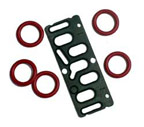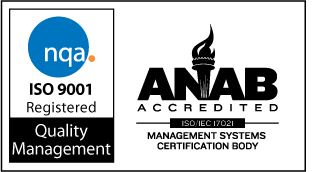
|
7108
S. Alton Way, Unit I |
(303) 758-2728
Home > Products > Metric O-rings
Metric O-rings and Seals
 If
you need metric o-rings or seals, please talk to us. We have some metric
sizes in stock and can ship immediately. If you have an unusual size we
do not stock, we can manufacture the part for you (there may be a tooling
charge however).
If
you need metric o-rings or seals, please talk to us. We have some metric
sizes in stock and can ship immediately. If you have an unusual size we
do not stock, we can manufacture the part for you (there may be a tooling
charge however).
In general, when you are thinking of o-rings for a product from the U.S., you are looking for o-rings measured in inches and when looking for a product manufactured in the rest of the world, you will want metric o-rings. However, the metric system is being used more and more in the U.S. for o-rings. The United States Metric Association says, "Just as English has become the global language of commerce, the metric system has become the global language of measurement."
BACKGROUND
The metric system was started way back in 1670 in France by Gabriel Mouton. He proposed a decimal system of measurement based on several physical measurements that will not vary. Over the years his work was improved on by a number of French scientists. Actually the metric system took quite a long time to become official in France (from 1670 to 1795) and went through periods of favor and disfavor during that time.
Eventually the metric system was adopted by almost all countries in the world, the U.S. being the notable exception. Because of the standardization of the measurements and the fact that math calculations are easy with the decimal system which is utilized by the metric system, it is well suited for all scientific and engineering work as well as for sizing o-rings.
Of course, metric o-rings are popular in a world which is rapidly developing technology. In the U.S. a law was passed in 1866 that said it is "lawful throughout the United States of America to employ the weight and measures of the metric system in all contracts, dealings or court proceedings." No law has been passed making the inch-pound system legal. The units of the inch-pound system were not officially defined in the courts until 1893 and then they were defined in terms of the metric standards.
A FEW CATEGORIES OF METRIC O-RINGS AND SEALS
Metric O-rings: These are seals that are shaped like a doughnut. They can be made from any elastomer such as FKM fluorocarbon, Kalrez, Simriz, nitrile, silicone, neoprene, polyurethane, FEP encapsulated elastomers, and more.
Dynamic O-rings and Seals: These are seals that are in an application where there are moving parts.
Static O-rings and Seals: Metric o-rings or seals in an application where nothing is moving.
Oil and Grease Seals: They are designed with a lip that fits tightly against a shaft or housing that prevents fluids from moving from one side of the seal to the other.
Wipers and V-ring Seals: These are called exclusion seals because they prevent fluids from moving from one side of the seal to the other.
Hydraulic and Pneumatic Seals: A class of seals that include piston seals, rod seals, u-cups, vee-packing and flange packings; hydraulic seals work in an application with fluids and pneumatic seals work with air.
Metric O-ring Belts: These are power transmission belts.
We are located in the Denver Technological
Center in a suburb of Denver, Colorado
©1997-2017, Problem Solving Products, Inc.
Website Map | Privacy Statement
| Terms of Use

